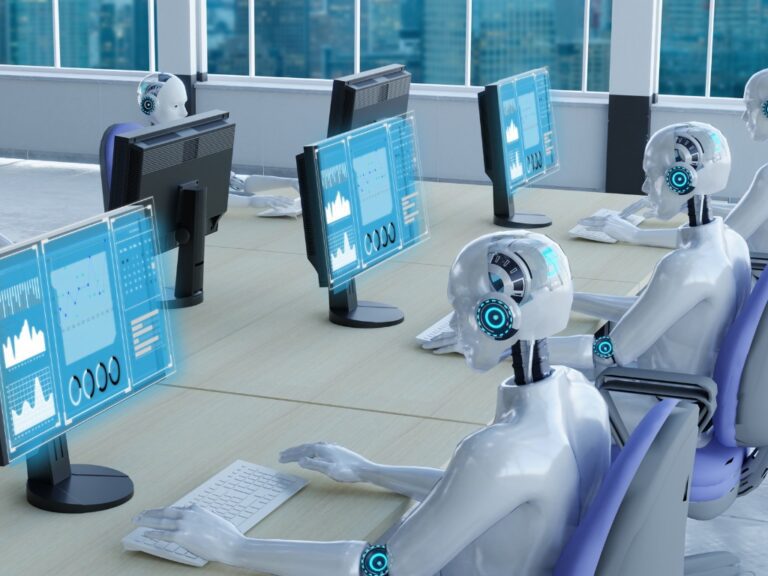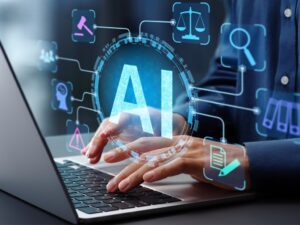Mitigating the Employment and Labor Law Risks of Robotics, Embodied AI
By Robert Botkin and Carson Lane
July 3, 2025

Robert Botkin is an attorney in Parker Poe’s Raleigh office, where he helps clients of all sizes, from Fortune 50 companies to startups navigate privacy and cybersecurity issues across different industries, including technology, retail, automotive, and finance.
Carson Lane is an employment attorney in Parker Poe’s Charlotte office, where she represents both large and small employers across a range of industries, including manufacturing, education, and health care.
Published in Today’s General Counsel, September/October 2025
As businesses increasingly adopt robotics and artificial intelligence (AI)—including “embodied AI” that combines physical robotics with AI—they must carefully manage the associated employment and labor law risks. While these technologies can enhance productivity, improve safety, and reduce costs, failure to navigate the complex legal landscape may lead to litigation, regulatory penalties, and reputational harm.
This issue is especially timely now, as businesses look to offset high domestic labor costs and navigate an unpredictable import tariff situation, which has prompted a shift of manufacturing operations to the United States. Let’s explore the key legal risks and offer strategies to mitigate them when integrating robotics into the workplace.
Managing Worker Displacement and Retention
Robotics in the workplace has the potential to displace human workers, one of the most significant labor concerns. In the event workers are displaced, employers must ensure compliance with applicable labor laws while also taking into consideration workforce morale and productivity.
- Compliance with WARN Act: If large-scale layoffs result from robotic integration, employers must comply with the federal Worker Adjustment and Retraining Notification (WARN) Act, which mandates advance notice for mass layoffs and plant closures. Many states impose their own often-stricter “miniWARN” statutes — so companies should verify and follow the most protective standard.
- Retraining and Redeployment Programs: By implementing reskilling initiatives and clear internal pathways to new positions, employers can help displaced workers transition to new roles, reducing the risk of wrongful termination claims and fostering goodwill.
- Union and Collective Bargaining Agreements: Employers must engage in good-faith discussions with unions when robotics impact bargaining unit employees, ensuring compliance with National Labor Relations Act (NLRA) obligations. As AI adoption grows, unions are seeking protections such as limits on job loss, retraining guarantees, and a role in evaluating new technologies.
Ensuring Workplace Safety and OSHA Compliance
While robotics can reduce workplace injuries, they can also create new hazards if not properly managed. The hazards can be caused by interference with the robots’ sensors, the introduction of new scenarios for which the robots’ algorithms do not have significant training, and of course, the possibility of human error when interacting with the robot.
- Occupational Safety and Health Administration (OSHA) Compliance: While OSHA does not yet have regulations that specifically address AI, employers must assess and mitigate risks associated with robotic systems under OSHA’s General Duty Clause.
- Robot Safety Standards: Employers should ensure their robotics provider maintains compliance with industrial robotics safety standards (such as ANSI/RIA R15.06), as well as standards on machine guarding.
- Employee Training and Incident Reporting: Workers should receive training on safely interacting with robotics, and employers should establish clear incident-reporting mechanisms.
Addressing Employee Monitoring and Privacy Concerns
Workplace robotics may involve real-time surveillance, biometric tracking, and AI-driven performance monitoring, which raises privacy concerns. Robots, especially embodied AI robots, may process personal data to properly function. For example, some robots require a fingerprint to engage the robot, while others process their surroundings and may be trained to recognize employees. Other robots that augment human workers may monitor the person’s performance to measure the impact of robotics on productivity.
- Compliance with Privacy Laws: Employers must adhere to state biometric privacy laws (such as the Illinois Biometric Information Privacy Act) and federal laws regarding employee data collection. State biometric privacy laws typically require prior written consent prior to the collection or processing of a person’s biometric data.
- Transparency: Informing employees about data collection, use, and retention practices may be required under certain state laws but may also help mitigate legal risk in states without a biometric privacy law.
Protecting Workers’ Rights and Avoiding Retaliation Claims
Introducing robotics may lead to changes in job roles, compensation structures, or working conditions, potentially triggering retaliation claims.
- Whistleblower Protections: Employees who raise concerns about potential safety violations or unethical use of technology are protected under federal and state whistleblower laws.
- Fair Labor Standards Act (FLSA) Compliance: The introduction of robotics in the workplace may lead some employers to misclassify employees under the FLSA. For example, maintenance staff who now work to maintain the workplace robots may be incorrectly reclassified as salaried, overtimeexempt “automation engineers” under the computeremployee exemption to the FLSA. However, the maintenance staff’s primary duties may still be manual repair and troubleshooting rather than more complex programming or systems analytics. Because those duties fall outside the exemption, the employees would still be nonexempt under the FLSA.
Drafting Robust Employment Policies and Contracts
To minimize litigation risks, employers should update employment policies and ensure their vendor contracts adequately protect the business against the risk robotics presents in their workplace.
- AI and Robotics Governance Policies: Clearly outline the ethical and legal use of AI and robotics in the workplace. These policies should be reviewed at defined intervals to ensure continuing alignment with emerging regulations, technological advances, and the organization’s risk tolerance.
- Indemnification and Vendor Agreements: Contracts with robotics vendors should include indemnification clauses to address liability for AI errors or malfunctions. Each agreement should also obligate the vendor to maintain sufficient cyber and professional liability insurance that names the employer as an additional insured and covers all AI-related losses.
- Workplace Technology Use Agreements: Employers should establish guidelines for employees interacting with AI-driven robotics to reduce operational risks. The agreement should expressly set acceptable-use parameters, data-handling obligations, and prompt reporting requirements for any anomalies or safety concerns.
Conclusion
As robotics and embodied AI become more commonplace in modern workplaces, employers must take proactive steps to mitigate employment and labor law risks. By prioritizing compliance with federal and state labor laws, implementing fair and transparent AI policies, and maintaining open communication with employees, businesses can harness the benefits of robotics while minimizing legal exposure. Companies that successfully navigate these challenges will position themselves as industry leaders, balancing innovation with ethical and legal responsibilities.
Must read intelligence for general counsel
Subscribe to the Daily Updates newsletter to be at the forefront of best practices and the latest legal news.
Daily Updates
Sign up for our free daily newsletter for the latest news and business legal developments.




